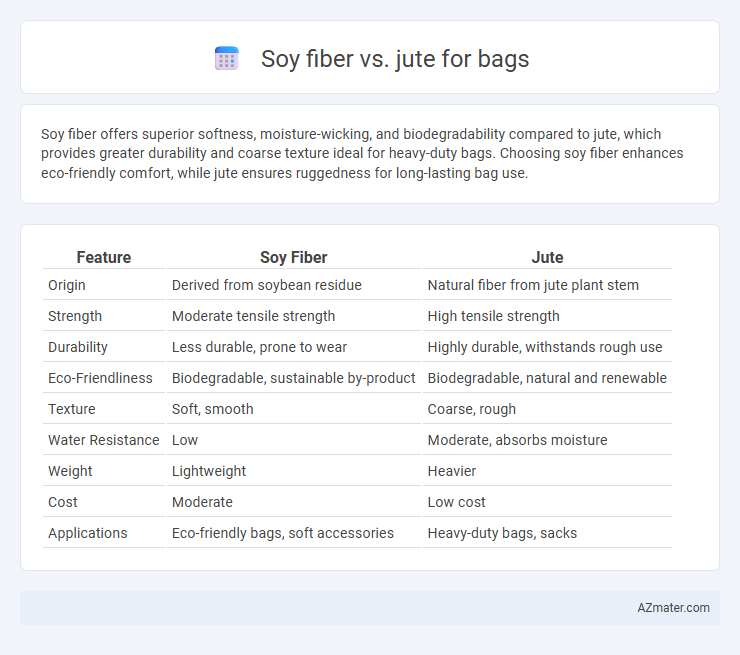Soy fiber offers superior softness, moisture-wicking, and biodegradability compared to jute, which provides greater durability and coarse texture ideal for heavy-duty bags. Choosing soy fiber enhances eco-friendly comfort, while jute ensures ruggedness for long-lasting bag use.
Table of Comparison
| Feature | Soy Fiber | Jute |
|---|---|---|
| Origin | Derived from soybean residue | Natural fiber from jute plant stem |
| Strength | Moderate tensile strength | High tensile strength |
| Durability | Less durable, prone to wear | Highly durable, withstands rough use |
| Eco-Friendliness | Biodegradable, sustainable by-product | Biodegradable, natural and renewable |
| Texture | Soft, smooth | Coarse, rough |
| Water Resistance | Low | Moderate, absorbs moisture |
| Weight | Lightweight | Heavier |
| Cost | Moderate | Low cost |
| Applications | Eco-friendly bags, soft accessories | Heavy-duty bags, sacks |
Introduction to Soy Fiber and Jute
Soy fiber, derived from the processing of soybean protein, offers a sustainable and biodegradable alternative for textile applications, including bag manufacturing. Jute, a natural bast fiber obtained from the stalks of the Corchorus plant, is well-known for its durability, eco-friendliness, and coarse texture ideal for sturdy bags. Both fibers provide environmentally conscious options, but soy fiber's soft texture and moisture absorption contrast with jute's roughness and high tensile strength.
Origins and Production Processes
Soy fiber, derived from the byproducts of soybean processing, originates primarily in regions with large soybean cultivation like the United States and Brazil, where the fiber is extracted by separating the protein-rich residues from the soybean hulls. Jute, grown mainly in Bangladesh and India, is obtained from the bast fibers of the jute plant through a water retting process that loosens the fibers from the stalks. The production of soy fiber involves a more refined, biochemical extraction method focused on sustainability and waste utilization, whereas jute production relies on a traditional, labor-intensive retting process that utilizes natural plant fibers for durability.
Environmental Impact: Soy Fiber vs Jute
Soy fiber bags boast a lower environmental footprint due to the renewable nature of soybeans and the biodegradability of the fiber, which decomposes quickly without releasing harmful toxins. Jute bags, derived from the jute plant, are also highly sustainable, requiring minimal water, pesticides, and fertilizers during cultivation, making them eco-friendly and carbon-negative by absorbing large amounts of CO2. Both materials offer biodegradable, renewable options, but jute's cultivation practices contribute more significantly to soil health and carbon sequestration compared to soy fiber production.
Strength and Durability Comparison
Soy fiber offers moderate tensile strength but falls short compared to jute's robust and coarse fibers, which provide superior durability for bag construction. Jute's natural lignin content enhances resistance to wear and environmental stress, making it ideal for heavy-duty use. Soy fiber bags may be more eco-friendly but generally require reinforcement to match jute's long-lasting performance in everyday or industrial applications.
Aesthetic Appeal and Texture Differences
Soy fiber bags exhibit a smooth, silky texture with a lustrous finish that enhances the aesthetic appeal, making them ideal for stylish, modern designs. Jute bags feature a coarse, rugged texture with a natural, earthy look that conveys durability and eco-friendliness, suitable for rustic or vintage styles. The tactile contrast between the soft, refined soy fiber and the coarse, textured jute influences consumer preference based on desired bag appearance and feel.
Biodegradability and Eco-friendliness
Soy fiber and jute both offer excellent biodegradability, breaking down naturally within months under composting conditions, minimizing environmental impact. Jute, derived from natural plant stalks, is highly eco-friendly due to its low water and pesticide requirements during cultivation, which reduces pollution and conserves resources. Soy fiber, a byproduct of soybean processing, enhances sustainability by utilizing agricultural waste, promoting a circular economy in bag manufacturing.
Cost and Market Availability
Soy fiber offers competitive pricing but remains less accessible in mass markets compared to jute, which is widely available and cost-effective due to its established supply chain. Jute's low production costs and high yield make it the preferred choice for economical bag manufacturing on a large scale. Market availability heavily favors jute, while soy fiber appeals mainly to niche segments seeking sustainable, plant-based alternatives despite higher prices.
Suitability for Bag Manufacturing
Soy fiber offers excellent suitability for bag manufacturing due to its softness, durability, and eco-friendly nature, making it ideal for lightweight and biodegradable bags. Jute, known for its high tensile strength and coarse texture, provides robustness and longevity, suited for heavy-duty and reusable bags. Both fibers contribute sustainable options, with soy fiber favored for smooth finishes and jute preferred for rustic, rugged designs.
Consumer Preferences and Trends
Soy fiber bags attract consumers seeking sustainable and biodegradable options with a soft texture and durability, appealing to eco-conscious buyers. Jute bags remain popular for their natural rustic look, high strength, and affordability, making them a preferred choice for everyday use and promotional purposes. Current trends show rising demand for soy fiber in premium, eco-friendly markets, while jute maintains dominance in mass-market and traditional segments.
Conclusion: Which is Better for Bags?
Soy fiber offers exceptional softness and biodegradability, making it ideal for eco-friendly, lightweight bags with a smooth texture. Jute is significantly stronger and more durable, providing excellent resistance to wear and tear, suitable for heavy-duty, rustic-style bags. For everyday use requiring toughness, jute outperforms soy fiber, while soy fiber suits sustainable, stylish bags where softness and comfort are prioritized.

Infographic: Soy fiber vs Jute for Bag
 azmater.com
azmater.com